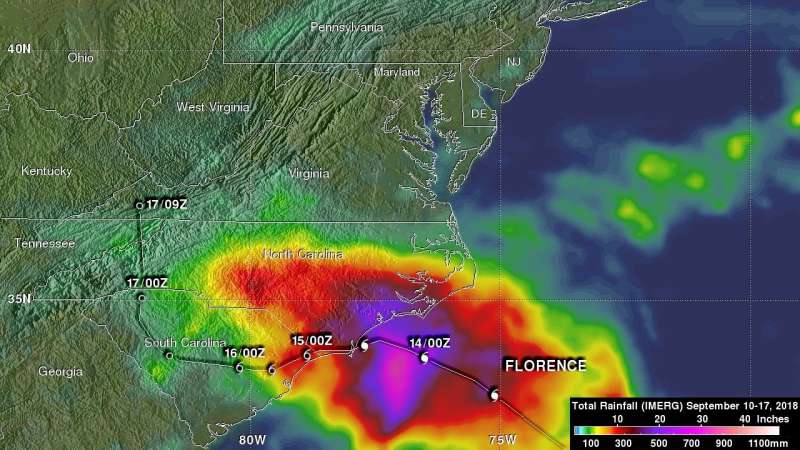NASA data shows Florence brings torrential rains and record flooding to the Carolinas

NASA estimated the precipitation generated by Hurricane Florence from Sept. 10 through 17 as it approached North Carolina and days after it made landfall. On Sept. 17, Florence's remnant rainfall was moving up the Appalachian Mountains into the Mid-Atlantic.
Florence's History
After making its way across the Atlantic, Florence, a once powerful Category 4 hurricane with maximum sustained winds reported at 140 mph by the National Hurricane Center (NHC), finally made landfall early Friday morning at around 7:15 a.m. EDT September 14th near Wrightsville Beach on the coast of North Carolina just east of Wilmington.
Although its maximum sustained winds had decreased to 90 mph when it made landfall, making it a Category 1 storm, Florence was still a very dangerous storm with a peak wind gust of 105 mph recorded at Wilmington, No. Carolina. By this time, Florence was a large storm with a large wind field.
Having undergone an eyewall replacement cycle on Sept. 11, wherein a new eyewall forms and replaces the original inner eyewall, Florence traded some of its peak intensity for size before reaching the coast. This kept the storm surge threat high even though the peak winds were down. New Bern, No. Carolina was hit by a reported 10 foot storm surge, which stranded many residents. In addition to its large size, Florence also slowed down as it approached the coast, allowing a good portion of its circulation to remain over water as it slowly made its way inland. This set the stage for a major flooding event over the Carolinas and was well forecast by NHC.
NASA Estimates Florence's Massive Rainfall
The Integrated Multi-satellitE Retrievals for GPM or IMERG is used to make estimates of precipitation from a combination of passive microwave sensors, including the GMI microwave sensor onboard the GPM or Global Precipitation Measurement mission satellite, and geostationary IR (infrared) data. GPM is a joint mission between NASA and the Japan Aerospace Exploration Agency, JAXA.
In an image created at NASA's Goddard Space Flight Center in Greenbelt, Md. the IMERG rainfall estimates associated with Florence for the 1-week period from Sept. 10 to 17 covered the central U.S. East Coast region where the storm came ashore. IMERG estimates show on the order of 250 mm of rain (~10 inches) or more reaching inland over most of central and southern North Carolina as well as the northeast corner of South Carolina.
However, along the southeast coast of North Carolina between Cape Fear and Cape Lookout rainfall amounts were much higher. There, where persistent rain bands rotated onshore bringing continuous bands of heavy rains onto the coast, IMERG estimates are on the order of 500 mm (~20 inches) or more. Locally, upwards of 30 inches of rain were reported in parts of North Carolina with reports of over 35 and 33 inches in Elizabethtown and Swansboro, respectively.
Record Rainfall in Wilmington, No. Carolina
As a result of receiving over 26 inches of rain from Florence, Wilmington set a new yearly rainfall record. The result of all of this rain has been record or major flooding along many of the rivers in North Carolina. At one point, Wilmington, No. Carolina was reportedly cut off. So far, Florence is being blamed for 20 fatalities.
Warnings and Watches Continue
At 11 a.m. EDT on Sept. 17, NOAA's National Weather Service Weather Prediction Center (WPC) in College Park, Md. issued the latest update on Tropical Depression Florence.
WPC said flash flood warnings are currently in effect across parts of central North Carolina into far southern Virginia. Flash flood watches are in effect across much of North Carolina, northern South Carolina, portions of Western Virginia, southern and eastern West Virginia, central and western Maryland, central and western Pennsylvania, southern New York and southern New England.
Status of Tropical Depression Florence on Sept. 17
At 11 a.m. EDT on Sept. 17 the WPC said,"Florence continues to produce heavy rain over parts of the Mid-Atlantic region. Flash flooding continues over the Carolinas and may develop across parts of the Delmarva Peninsula into Pennsylvania today."
At 1100 AM EDT (1500 UTC), the center of Tropical Depression Florence was located near latitude 38.5 degrees north and longitude 82.9 degrees west. That's about 240 miles (385 km) west of Charlottesville, Virginia. The depression is moving toward the northeast near 15 mph (24 kph) and is forecast to become extratropical late today while accelerating to the east-northeast. Maximum sustained winds are near 25 mph (35 kph) with higher gusts. Little change in strength is forecast until the low moves into the western Atlantic by early Wednesday. The estimated minimum central pressure is 1008 millibars.
More Rain from Florence over Next Few Days
The WPC forecast stated: "Florence is expected to produce heavy to excessive rainfall over the next couple of days. Portions of the Mid-Atlantic states west of Interstate 95 into southern New York and southern New England are expected to receive an additional 2 to 4 inches of rain with isolated maximum amounts of 6 inches possible."
Provided by NASA's Goddard Space Flight Center

















